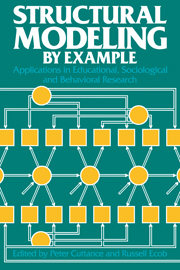Book contents
- Frontmatter
- Contents
- Preface
- List of contributors
- 1 Introduction
- 2 An overview of structural equation modeling
- 3 Field dependence and the differentiation of neurotic syndromes
- 4 High school seniors' reports of parental socioeconomic status: black–white differences
- 5 Modeling the hierarchical structure of learning
- 6 A study of longitudinal causal models comparing gain score analysis with structural equation approaches
- 7 Some structural equation models of sibling resemblance in educational attainment and occupational status
- 8 Applications of structural equation modeling to longitudinal educational data
- 9 The robustness of maximum likelihood estimation in structural equation models
- 10 An inquiry into the effects of outliers on estimates of a structural equation model of basic skills assessment
- 11 Testing structural equation models
- 12 LISREL models for inequality constraints in factor and regression analysis
- 13 Issues and problems in the application of structural equation models
- Appendix
- Glossary
- Index
13 - Issues and problems in the application of structural equation models
Published online by Cambridge University Press: 12 January 2010
- Frontmatter
- Contents
- Preface
- List of contributors
- 1 Introduction
- 2 An overview of structural equation modeling
- 3 Field dependence and the differentiation of neurotic syndromes
- 4 High school seniors' reports of parental socioeconomic status: black–white differences
- 5 Modeling the hierarchical structure of learning
- 6 A study of longitudinal causal models comparing gain score analysis with structural equation approaches
- 7 Some structural equation models of sibling resemblance in educational attainment and occupational status
- 8 Applications of structural equation modeling to longitudinal educational data
- 9 The robustness of maximum likelihood estimation in structural equation models
- 10 An inquiry into the effects of outliers on estimates of a structural equation model of basic skills assessment
- 11 Testing structural equation models
- 12 LISREL models for inequality constraints in factor and regression analysis
- 13 Issues and problems in the application of structural equation models
- Appendix
- Glossary
- Index
Summary
Introduction
Although structural equation and covariance structure modeling has become more widely used during the past few years, there have been numerous suggestions that it may not be suitable for many of the models and data found in the social and behavioral sciences. Several studies of the behavior of structural modeling methods in conditions that approximate those found in practice have now been completed. They provide a fairly clear idea of when these methods are appropriate given particular model and data conditions.
Chapter 2 in this volume sets out the statistical model in matrix notation and specifies the assumptions required in order to estimate and test its fit to data. In this chapter we discuss methodological and statistical issues encountered in the application of structural modeling. Particular attention is paid to the evaluation of the robustness of the method to violation of the assumptions made in estimating the parameters of the model and testing its fit to the data.
General methodological and statistical issues
In this section we discuss several methodological issues encountered in the application of structural equation modeling. These include the specification of alternative models, the choice of a statistic to represent the relationship between noninterval measurement scales, the treatment of interactions, the relationship between exploratory and confirmatory modeling, and issues arising from the unit of analysis and sampling method employed in the collection of nonexperimental data.
Exploratory and confirmatory methods
The basic difference between exploratory and confirmatory modeling is related to the way that theory and data interact in the analysis.
- Type
- Chapter
- Information
- Structural Modeling by ExampleApplications in Educational, Sociological, and Behavioral Research, pp. 241 - 279Publisher: Cambridge University PressPrint publication year: 1988
- 4
- Cited by



